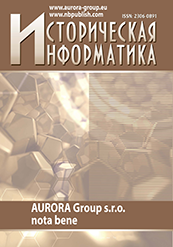In Memoriam
Правильная ссылка на статью:
Бородкин Л.И., Валетов Т.Я., Гарскова И.М., Саломатина С.А.
Памяти Тамары Федоровны Изместьевой (16.10.1941 – 19.02.2024)
// Историческая информатика.
2024. № 1.
С. 183-188.
DOI: 10.7256/2585-7797.2024.1.70354 EDN: EWZNQX URL: https://nbpublish.com/library_read_article.php?id=70354
Читать статью
Результаты процедуры рецензирования статьи:
|
EDN: EWZNQX

|
Аннотация:
Эта мемориальная статья посвящена памяти Тамары Федоровны Изместьевой, известного специалиста в области экономической истории и исторической информатики, чья жизнь была неразрывно связана с МГУ. Выпускница экономического факультета МГУ, Тамара Федоровна начала научную и преподавательскую работу на истфаке в 1969 году на кафедре источниковедения, затем как научный и старший научный сотрудник межкафедральной лаборатории исторической информатики, преобразованной в 2004 году в одноименную кафедру. Научные интересы Тамары Федоровны лежали в русле как экономической истории, так и исторической информатики. В 1991 году издательство МГУ опубликовало монографию по материалам ее диссертации «Россия в системе европейского рынка, конец XIX – начало XX века (Опыт количественного анализа)». Т.Ф.Изместьева вошла в число учредителей Ассоциации «История и компьютер» (АИК), она была членом оргкомитетов многих конференций АИК, руководила работой секций по социально-экономической и квантитативной истории, участвовала в организации школ молодых ученых. В статье использованы публикации Т.Ф. Изместьевой в журналах "Отечественная история", "Экономическая история. Обозрение", "Историческая информатика", "Информационный бюллетень АИК", материалы ее докладов и сообщений на российских и международных конференциях и семинарах, воспоминания коллег, студентов и аспирантов исторического факультета МГУ о совместном участии в архивных информационных проектах и образовательных программах. В статье дается высокая оценка научно-исследовательской и преподавательской работы Т.Ф. Изместьевой, ее участия в научно-организационной работе. Публикации по экономической истории отражали ее интересы в области изучения внешнего рынка Российской империи, анализа массовых статистических источников. Тамара Федоровна вводила в исследования по экономической истории «экономический инструментарий»: производственные функции, коэффициенты структурных сдвигов, финансово-производственные характеристики. В области исторической информатики Т.Ф. Изместьева уделяла много внимания созданию историко-ориентированных баз данных и других электронных ресурсов, источниковедческим и методическим проблемам работы с массовыми статистическими данными. Она являлась соавтором целого ряда учебников и учебных пособий, среди которых «Количественные методы в исторических исследованиях», «Историческая информатика», «Компьютеризованный статистический анализ для историков», «Информатика для гуманитариев» , «Информационные технологии для историков».
Ключевые слова:
статистика, база данных, промышленность, источниковедение, историческая информатика, экономическая история, квантитативная история, публикации, проекты, преподавание
Abstract:
This article is dedicated to the memory of Tamara Fedorovna Izmestyeva, a well-known specialist in the field of economic history and historical information science. A graduate of the Faculty of Economics of Moscow State University, she began her scientific and teaching work at the Faculty of History in 1969 at the Department of Source Studies, then as a researcher and senior researcher at the interdepartmental Laboratory of Historical Information Science, transformed into the Department of the same name. Tamara Fyodorovna's research interests lay in the mainstream of both economic history and historical information science. In 1991, the publishing house of Moscow State University published a monograph based on her dissertation "Russia in the European market system, late XIX – early XX century". T.F.Izmestyeva became one of the founders of the Association "History and Computer" (AIK), she was a member of the organizing committees of many AIK conferences, participated in the organization of schools for young scholars. The article uses publications by T.F. Izmestyeva in the journals "Russian History", "Economic History. Review", "Historical Information Scince", "AIK Newsletter", her presentations at Russian and international conferences, memoirs of colleagues and students. The article gives a high assessment of T.F. Izmestyeva's research and teaching work. Publications on economic history reflected her interests in the field of studying the foreign market of the Russian Empire, analyzing mass statistical sources. Tamara Fyodorovna introduced "economic tools" into research on economic history. In the field of historical information science, she paid much attention to the creation of historically oriented databases, source studies and methodological problems of working with mass statistical data. She has co-authored a number of textbooks, including "Quantitative Methods in Historical Research", "Historical Information Science", "Computerized Statistical Analysis for Historians", "Inforfmation Science for Humanities", "Information Technology for Historians".
Keywords:
projects, publications, statistics, industry, data base, source study, historical information science, economic history, quantitative history, teaching
 Статья опубликована с лицензией Creative Commons Attribution-NonCommercial 4.0 International License (CC BY-NC 4.0) – Лицензия «С указанием авторства – Некоммерческая».
Статья опубликована с лицензией Creative Commons Attribution-NonCommercial 4.0 International License (CC BY-NC 4.0) – Лицензия «С указанием авторства – Некоммерческая». Рус
Рус














 © 1998 – 2024 Nota Bene. Publishing Technologies. NB-Media Ltd.
© 1998 – 2024 Nota Bene. Publishing Technologies. NB-Media Ltd.




